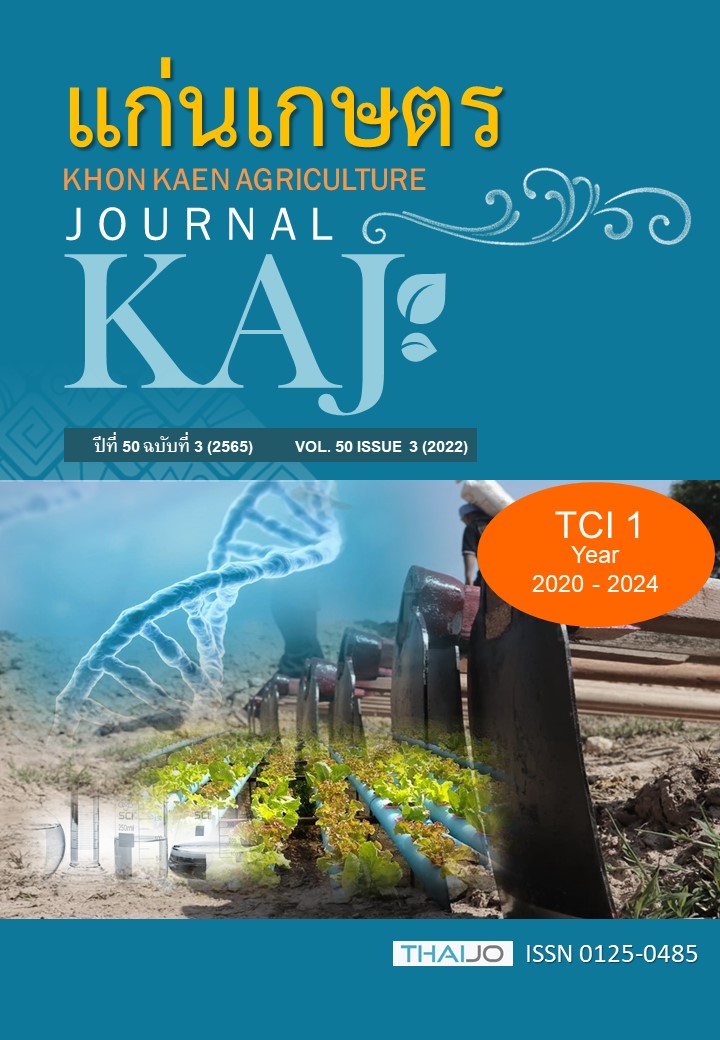Effect of oat (Avena sativa L.) genotype and germination time on functional properties and nutritional value of oat flour
Main Article Content
บทคัดย่อ
Germination of whole grain was improved its nutritive value and physical properties of whole grain flour. Thus, the influent of oat genotype and geminated time on physical properties and nutritive value of germinated oat flour were investigated. The experimental design was 2´3 factorials in completely randomized design (CRD). The two varieties oat seeds (AUSOAT and FAMGOA from Maehongsorn Rice Research Center, Thailand) were cleaned, washed, steeped and germination at 35 ± 2°C and 95 ± 2% relative humidity for 0, 12 and 24 h prior dried to 14 % moisture content. The dried germinated oat grain were de-hulled and milled pass through 80 mesh screen to produced germinated oat flour (GOF). The husked yield, flour yield, water absorption index, water soluble index, color value, moisture content, protein, fat, fiber, ash, carbohydrate, and dietary fiber content of the GOF were determined. The results revealed that the oat genotype was not significant affected on chemical composition and functional properties of GOF. However, the long germination time was dramatically reduced on soluble dietary fiber and carbohydrate content. In addition, the GOF produced from 12 h germination of AUSOAT and FAMGOAP genotypes had the highest in water absorption index and water soluble index same as whole wheat flour. Thus, the 12 h GOF was an appropriate for utilization as healthy food ingredients especially in various cereal breakfast and bakery products.
Article Details

อนุญาตภายใต้เงื่อนไข Creative Commons Attribution-NonCommercial-NoDerivatives 4.0 International License.
เอกสารอ้างอิง
American Associate Cereal Chemistry. 2001. The definition of dietary fibre. Report of the dietary fibre definition committee to the board of directors of the American Association of Cereal Chemistry. Cereal Foods World. 46: 112–129.
Aparicio-García N., C. Martínez-Villaluenga, J. Frias, and E. Peñas. 2020. Changes in protein profile, bioactive potential and enzymatic activities of gluten-free flours obtained from hulled and de-hulled oat varieties as affected by germination conditions. LWT-Food Science and Technology. 134: 1-8.
Ballabio C., U. Francesca, M. Sara, V. Elisabetta, B.R. Gaetano, and E. Penas. 2011. Molecular characterization of 36 oat varieties and in vitro assessment of their suitability for coeliac s’ diet. Journal of Cereal Science. 54: 110-115.
Barry V. McCleary, Naomi Sloane, Anna Draga and Ida Lazewska. 2013. Measurement of total dietary fiber using AOAC Method 2009.01 (AACC International Approved Method 32- 45.01): evaluation and updates. Cereal Chem. 90(4): 396-414.
Binqiang T., X. Bijun, S. John, W. Jia, C. Yan, X. Tuoming, X. Sophia, and D. Qianchun. 2010. Physicochemical changes of oat seeds during germination. Food Chemistry. 119: 1195–1200.
Boukid F., B. S. PrandiBarbara, and S. Sforza. 2017. Effectiveness of germination on protein hydrolysis as a way to reduce adverse reactions to wheat. Journal of Agriculture and Food Chemistry. 65: 9854–9860.
Cáceres P., M. V. Cristina, A. Lourdes, and F. Juana. 2014. Maximizing the phytochemical content and antioxidant activity of Ecuadorian brown rice sprouts through optimal germination conditions. Food Chemistry. 152: 407-414.
Capouchova I., J. Petr, and L. Krejcirova. 2006. Protein composition of sorghum and oat grain and their suitability for gluten-free diet. Agricultural. 93(4): 271–284.
FAO. 2010. FODDER OATS: a world overview. Food and Agriculture Organization of the United Nations Rome. Available: http://www.fao.org/3/y5765e/y5765e00.htm. Accessed Nov.1, 2020.
Francis W., and W. Peter. 2011. Oats Chemistry and Technology. A volume in American Association of Cereal Chemistry International. 347-361.
Girardet N., and F.H. Webster. 2011. Oat milling: specifications, storage, and processing pp. 301-39. In F.H. Webster, and P.J. Wood, Oats: Chemistry and Technology, 2nd In: F.H. Webster and P.J. Wood sciencedirect.com /book/9781891127649/oats.
Hsueh C. W., C.Y. Hung, J.D. Hsu, M.Y. Yang, J.W. Shing, and J.W. Chau. 2011. Inhibitory effect of whole oat on aberrant crypt foci formation and colon tumor growth in ICR and BALB/c mice. Journal Cereal Science. 53: 73–77.
Hübner F., O. Tonya, D. C. Kavin, and K. Elke. 2010. The influence of germination conditions on beta‐glucan, dietary fibre and phytate during germination of oats and barley. European Food Research and Technology. 231: 27–35.
Kaukovirta-N., W. Annika, and P. Kaisa. 2004. Germination: a means to improve the functionality of oat. Agricultural and Food Science. 13: 100-112.
Liu Y. and J. W. Pamela. 2011. Molecular weight and structure of water soluble (1 →3),(1→4)-βglucans affect pasting properties of oat flours. Journal of Food Science. 76: C68-C74.
Mc Cleary Barry., Sloane, AnnaDraga and Ida Lazewska. 2013. Measurement of total dietary fiber using AOAC Method 2009.01 (AACC International Approved Method 32- 45.01): evaluation and updates. Cereal Chem. 90(4): 396-414.
Meixue Z., K. Robards, M. Glenn-Holmes, and S. Helliwell 1988. Structure and pasting properties of oat starch. Cereal Chemistry 75(3): 273-281.
Othman R., A. Moghadasian, H. Mohuammed, and J. Peter. 2011. Cholesterol-lowering effects of oat β-glucan. Nutrition Review. 69(6): 299-309.
Prasad R., J. Alok, S. Latha, K. Arvind, and V. S. Unnikrishnan. 2015. Nutritional advantages of oats and opportunities for its processing as value added foods - a review Journal of Food Science and Technology. 52(2): 662–675.
Singh R., D. Subrata, and B. Asma. 2013. Avena sativa (Oat), a potential neutraceutical and therapeutic agent: an overview. Critical Review in Food Science and Nutrition. 53(2): 126-144.
Teixeira C., M. Nyman, A. Roger, and A.M. Marie. 2016. Effects of variety and steeping conditions on some barley components associated with colonic health. Journal of the Science. of Food and Agricultural. 96: 4821-4827.
Yagci S, and G. Fahrettin. 2009. Effect of incorporation of various food by-products on some nutritional properties of rice-based extruded foods. Food Science and Technology International. 15(6): 571-581.
Yong Y., H. Yue-ao., H. S. Mohamad, R. Chang-zhong, C. Lai-chunGuo, and Z. Z. Wang. 2017. Organic matter, protein percentage, yield, competition and economics of oat-soybean and oat-groundnut intercropping systems in northern china. Cercetări agronomice în moldova. 3(171): 25-35.
Zhang M., B. Xin, and Z. Zhang. 2011. Extrusion process improves the functionality of soluble dietary fiber in oat bran. Journal Cereal Science. 54: 98–103.


